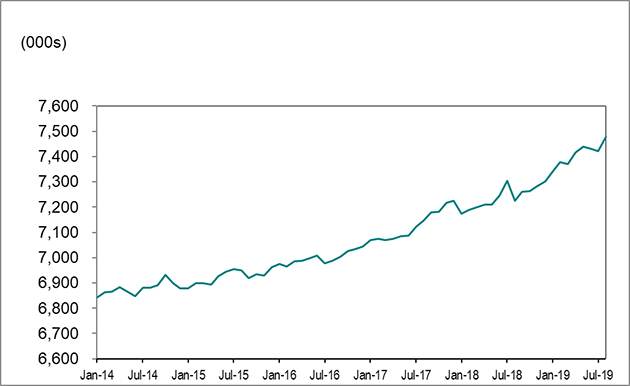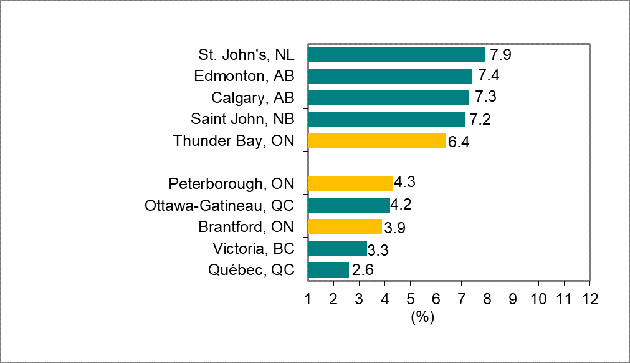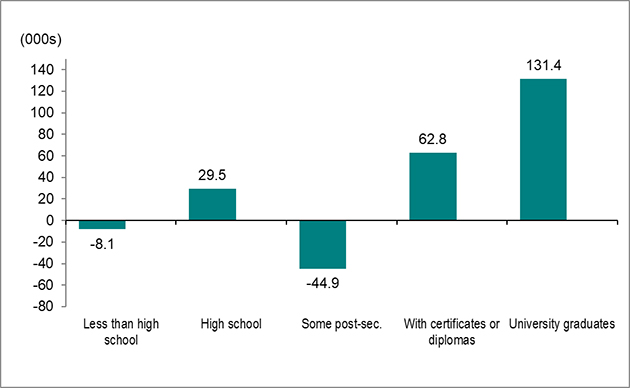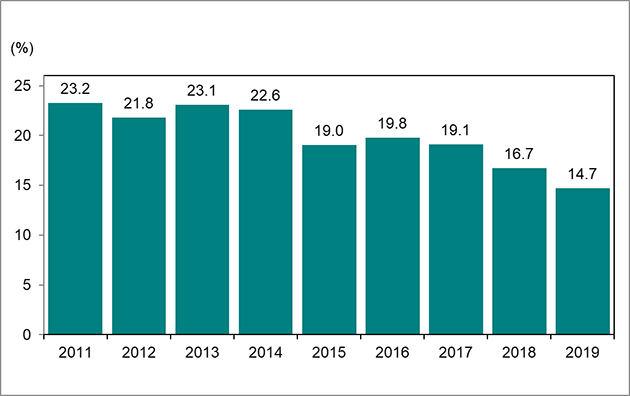Labour market report, August 2019
Employment in Ontario increased in August. Get the details in this report.
Quick facts
In August 2019:
- There were 12.2 million people in Ontario aged 15 years or older
- 7.9 million (65%) were either working or actively looking for work
- 7.5 million (61%) were employed and 81% of them had a full-time job
- Ontario's unemployment rate was 5.6% (445,700 unemployed people)
Employment increased in August
Employment in Ontario increased by 57,800 in August after decreasing by 10,700 jobs in July. August’s increase was the second largest on record after January 1989 (58,500).
Chart 1 shows employment in Ontario from January 2014 to August 2019.

Source: Statistics Canada, Labour Force Survey, Table 14-10-0287-01, (seasonally adjusted data).
Full-time vs. part-time
Part-time employment climbed by 61,000 and accounted for all the net job gains. Full-time jobs declined by 3,200.
Employment increase/decrease by age
Youth employment (those aged 15 to 24) increased by 27,700 jobs in August, after decreasing by 14,600 jobs in July.
Employment for people aged 25 to 54 increased by 4,300 in August, compared to July. Employment for those aged 55 and older increased by 25,800 jobs.
Employment in Canada increased by 81,100 in August, after declining by 24,200 jobs in July.
Unemployment rate decreased to 5.6%
Chart 2 shows unemployment rates, Ontario and Canada, January 2014 to August 2019.

Source: Statistics Canada, Labour Force Survey, Table 14-10-0287-01, (seasonally adjusted data).
Ontario’s unemployment rate decreased to 5.6% in August from 5.7% in July. Ontario’s unemployment rate has remained at or below 6.0% since August 2017.
Canada’s unemployment rate remained at 5.7% in August compared to July.
Unemployment rate by age
For people aged 15 to 24, the unemployment rate was 12.2% in August, down from 12.9% in July.
The unemployment rates for people aged 25 to 54 increased to 4.7% in August from 4.6% in July and decreased to 4.1% from 4.3% for those aged 55 and older.
Lowest and highest unemployment rates
Chart 3 shows Census Metropolitan Areas (CMAs) with highest and lowest unemployment rates in Canada, August 2019.

Source: Statistics Canada, Labour Force Survey, Table 14-10-0294-01, (seasonally adjusted data three-month moving average to reduce volatility caused by small sample size).
Thunder Bay recorded the highest unemployment rate in Ontario in August (6.4%), while St. John’s, Newfoundland recorded the highest unemployment rate in Canada (7.9%).
Brantford recorded the lowest unemployment rate in Ontario in August (3.9%), while Québec City recorded the lowest unemployment rate in Canada (2.6%).
Year-over-year comparisons
Over the first eight months of 2019, employment in Ontario increased by 170,800 net jobs for adults 25 years and older compared to the first eight months of 2018.
Employment increase and decrease by education level
Chart 4 shows Ontario employment change by highest level of education attained, aged 25 and older, August 2018 year-to-date to August 2019 year-to-date.

Source: Statistics Canada, Labour Force Survey, Table 14-10-0019-01, unadjusted data
Adults with a university degree led gains with 131,400 net new jobs, followed by those with a postsecondary certificate or diploma (62,800)
Individuals with some postsecondary education recorded job losses of 44,900.
People with less than high school education also recorded job losses (8,100), while those with high school education recorded job gains of 29,500.
Unemployment rate by education level
The unemployment rate for adults aged 25 and older with postsecondary education credentials was 4.2% in the first eight months of 2019, down from 4.3% a year earlier.
The unemployment rate for adults without postsecondary education credentials was 6.2%, up from 6.0% a year ago.
Employment increase and decrease by occupation
Chart 5 shows Ontario employment change by occupation, August 2018 year-to-date to August 2019 year-to-date.

Source: Statistics Canada, Labour Force Survey, Table 14-10-0297-01, unadjusted data.
Nine of the ten major occupational groups in Ontario had net employment gains over the first eight months of 2019 compared to a year earlier.
Learn more about the National Occupational Classification (NOC) system.
These occupations gained the most jobs:
- sales and service (47,900)
- trades, transport and equipment operators (46,800)
- natural and applied sciences and related (41,400)
This occupation lost jobs:
- manufacturing and utilities (20,400)
Long-term unemployment decreased
Chart 6 shows Ontario's long-term unemployed (27 weeks or more) as a percentage of total unemployment, August 2011 year-to-date to August 2019 year-to-date

Source: Statistics Canada, Labour Force Survey, Table 14-10-0056-01, unadjusted data.
Over the first eight months of 2019, an average of 68,200 people were unemployed for 27 weeks or longer, or long-term unemployed. This was down from 75,300 a year earlier.
Long-term unemployed individuals accounted for 14.7% of the total number of unemployed people in the first eight months of 2019. This compared with 16.7% a year earlier.
Average time in long-term unemployment
The average time in unemployment decreased to 15.4 weeks over the first eight months of 2019, down from 17.1 weeks a year earlier.
Download data
Source: Statistics Canada, Labour Force Survey
August 2019 Labour Market Report:
- CSV, Chart 1, employment in Ontario from January 2014 to August 2019, 1KB
- CSV, Chart 2 unemployment rates, Ontario and Canada, January 2014 to August 2019, 2KB
- CSV, Chart 3 Census Metropolitan Areas (CMAs) highest and lowest unemployment rates, 2KB
- CSV, Chart 4, Ontario employment change by highest level of education, aged 25 and older, 99KB
- CSV, Chart 5, Ontario employment change by occupation 12KB
- CSV, Chart 6, Ontario's long-term unemployed, 15KB